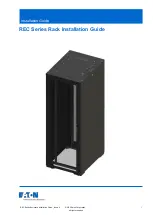
Hardware options installation 33
Lockstep mode uses channel 1 and channel 2. Channel 3 is not populated. Because channel 3 cannot be
populated when using Lockstep mode, the maximum memory capacity is lower than Advanced ECC
mode. Memory performance with Advanced ECC is also slightly higher.
General DIMM slot population guidelines
Observe the following guidelines for all AMP modes:
•
Populate DIMM slots for a processor only if the processor is installed.
•
To maximize performance in multi-processor configurations, distribute the total memory capacity
between all processors as evenly as possible.
•
Do not mix Unbuffered and Registered PC3 DIMMs.
•
Each channel supports up to two Unbuffered DIMMs.
•
If quad-rank DIMMs are installed for a processor, a maximum of two DIMMs can be installed on
each channel for that processor.
If a channel contains quad-rank DIMMs, the quad-rank DIMM must be installed first on that channel.
DIMM speeds are supported as indicated in the following table.
Populated slots
(per channel)
Rank Speeds
supported
(MHz)
1
Single- or dual-rank
1333, 1066
1 Quad-rank 1066
2
Single- or dual-rank
1066
Advanced ECC population guidelines
For Advanced ECC mode configurations, observe the following guidelines:
•
Observe the general DIMM slot population guidelines (on page
33
).
•
DIMMs may be installed individually.
Single-processor Advanced ECC population order
For Advanced ECC mode configurations with a single processor, populate the DIMM slots in the following
order:
•
RDIMM: Sequentially in alphabetical order (A through F)
•
UDIMM: Sequentially in alphabetical order (A through F).
Multi-processor Advanced ECC population order
For Advanced ECC mode configurations with multiple processors, populate the DIMM slots for each
processor in the following order:
•
RDIMM: Sequentially in alphabetical order (A through F)
•
UDIMM: Sequentially in alphabetical order (A through F).















































